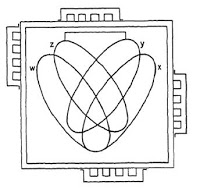Holological Reflection
Armahedi Mahzar (c) 2015
In my previous blog, I was telling you a my story of logic in a subjective perspective. In the end of the story I invite readers to join my new egroup holologics@yahogroups.com. Well, what is holologics? Holologics is a study of logics as parts of an integral whole as an abstract object LOGIC in the subspace of the Platonic mathematical space of numbers and forms. It seems that the object LOGIC is a network of logics as abstract system in the ideal world of Plato. Its realizations in material world had been emerging as parts of the development of human civilization in response to technological revolutions.
Firstly, logic as a science was studied verbally by Aristotle who symbolized the terms of a syllogism with letters. Structurally, a syllogism can be seen as three propositions containing three types of letter each one is occuring once in each proposition. The first pair of proposition is called premises and the last proposition is called conclusion. I will call Aristotlean logic as logologic as the concise term for word logic. The logological revolution followed the agricultural urban revolution.
When Gutenberg . invented the manual operated print there was an information revolution with the accumulation of books which brought the renaissance in the continent of Europe. Gottfried Wilhelm Leibniz  is the child of renaissance who invented differential calculus which later is becoming a basic tools for the whole new mechanics which becomes the model for the modern science. He dreamed that sometime in the future calculus rationicator will be developed. He also developed a graphical method to solve syllogistic problem in the form of circles and lines diagrams
is the child of renaissance who invented differential calculus which later is becoming a basic tools for the whole new mechanics which becomes the model for the modern science. He dreamed that sometime in the future calculus rationicator will be developed. He also developed a graphical method to solve syllogistic problem in the form of circles and lines diagrams and made arithmetical models for syllogistic. Johann Heinrich Lambert
 developed another type of line diagram
developed another type of line diagram and Gottfried Ploucquet
 improved Lambert diagrams into a simple line diagrams
improved Lambert diagrams into a simple line diagrams  . Leibniz, Lambert and Ploucquet made a revolutionary method in logic: creating pictorial logic or pictologic. Pictological revolution is driven by Gutenberg revolution.
. Leibniz, Lambert and Ploucquet made a revolutionary method in logic: creating pictorial logic or pictologic. Pictological revolution is driven by Gutenberg revolution.
In the nineteenth century George Boole make a revolutionary step in logic by replacing words of aristotle with mathematical symbols so every propositions is expressed by an algebraic equations, and reasoning become eliminations of variables in a system of equations. I will call such algebraic method as algologic as concise term for algebraic logic. The algological revolution is following the mechanical industrial revolution.
Charles Sanders Peirce and Gottlob Frege
 make another revolution when they represented any logical expressions as diagrams in two dimensional space. Peirce used circles
make another revolution when they represented any logical expressions as diagrams in two dimensional space. Peirce used circles  and Frege used trees
and Frege used trees  . Later, George Spencer-Brown
. Later, George Spencer-Brown used crosses
 and Louis Kauffman
and Louis Kauffman  used boxes
used boxes  as parts of their expressions of logical propositions. This is a pictological revolution was following the electrical industrial revolution.
as parts of their expressions of logical propositions. This is a pictological revolution was following the electrical industrial revolution.
Fred Sommers  invented a logical system called as term functor logic which is a return to the Aristotlean tradition of making the verbal language as the foundation of logic. Of course he used arithmetical symbols to analyzed verbal propositions, but essentially the analysis can be made totally verbal. Fred Sommers followed by George Englebretsen
invented a logical system called as term functor logic which is a return to the Aristotlean tradition of making the verbal language as the foundation of logic. Of course he used arithmetical symbols to analyzed verbal propositions, but essentially the analysis can be made totally verbal. Fred Sommers followed by George Englebretsen
, who in the spirit of pictological revolution, developed a line diagram method for doing a logical reasoning. However, I think that Sommers was generated a second logological revolution for doing logic with words.
Inspired by pictologic which still used letters as representation of variable, I replaced letters with the pictures of colored objects to create what I called as objective logic algebra ![]() . Calculating logic with objective algebra, I am inspired to replace boxes and trees with real objects like cards and sticks to transform the algebras of logic into games of thing
. Calculating logic with objective algebra, I am inspired to replace boxes and trees with real objects like cards and sticks to transform the algebras of logic into games of thing  . I will call my three dimensional method as hylologic as the concise term for object logic. Hylological revolution is following informational electronic revolution.
. I will call my three dimensional method as hylologic as the concise term for object logic. Hylological revolution is following informational electronic revolution.
I think my discovery is only a last step in the chain of a long tradition of doing logic with devices. John Venn  the discoverer of Venn method used movable parts of wooden ellipses
the discoverer of Venn method used movable parts of wooden ellipses  . William Stanley Jevons
. William Stanley Jevons  created a logical piano
created a logical piano  to reason with syllogism. Allan Marquand
to reason with syllogism. Allan Marquand
 improved Jevon’s machine to make his own logical machine
improved Jevon’s machine to make his own logical machine  . Peirce transformed Marquand mechanical machine into an electromagnetic logical machine
. Peirce transformed Marquand mechanical machine into an electromagnetic logical machine  . Today we have computers as a logical machines.
. Today we have computers as a logical machines.Logologic, algologic, pictologic and hylologic are representations of the abstract logic. As I see it now, the process of realization seems to be following a path of methodological simplification. The egroup holologics@yahoogroups.com is created to be a forum to refine and perfect all logics mentioned above in a free and open discussion. You are invited to join the logic REVOLUTION 🙂